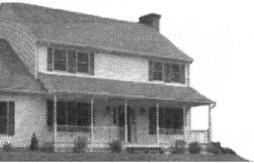






































By Monica C ardoza
The Washington Post
CONVENTIONAL
WIS
-
dom is that if you cultivate host plants, butterflies will come. Take, for example, milkweed. After declining monarch populations began making headlines in the late 1990s, people nationwide planted the orange-and-black-winged pollinator’s “host” plant to give the females a place to lay their eggs, and the caterpillars a source of food. The result: Eastern monarch butterfly populations have shown signs of rebounding, though Western populations have not fared as well, possibly due to triple-digit heat and wildfires destroying their overwintering habitats.
Now, after a recent study published in the journal Science, scientists are hoping other butterfly species will get similar attention. The study found that from 2000 to 2020, the United States lost 22 percent of its butterflies, with even common species experiencing declines. While the study didn’t examine the reasons for the decline, the researchers suggest climate change, habitat loss and insecticides are the probable culprits.
“When we saw the results of our work, we hoped that people would hear the message and want to do things to make our world better for butterflies,” says Erica Henry, a prairie ecologist with the Washington Department of Fish and Wildlife and co-author of the study.
Here’s what to know about planting to help sustain your local butterfly populations.
Know your butterfly species
You have to be realistic about what you can attract, says Sharon Wander, an ecologist and past president of the New Jersey Butterfly Club. She has attracted some 85 species to her three-acre yard in Fredon, New Jersey, since she and her husband, Wade, began recording them more than 30 years

ago. “Bringing back endangered species isn’t something for the gardener to have as a goal,” she says. “What you can do is help the ones that are still reasonably common.”
If, like me, you regularly snap photos of the butterflies in your garden or on walks in your neighborhood, open them and search online or use a field guide to determine their species. Last summer, I discovered that I had Eastern tiger swallowtails, a black swallowtail and monarchs in my yard, and I spied a red admiral a couple of blocks from my home.
The online or app version of the community science tool iNaturalist can help you see which species were recorded near you last year. Native plant nurseries and state departments of natural resources may also have information specific to your region. Or try consulting the North American Butterfly Association, which has 24 chapters in 14 states.
As an experiment for this article, Wander asked ChatGPT to name the five most common butterflies in her area. “It gave me a pretty good list,” she says. “Then it asked: ‘Would you like to know about the host plants for this butterfly?’ You can come up with a lot of information using that tool, but it still needs to be fact-checked.”
Provide lots of nectar
Butterflies get their energy from nectar. Some species
trees, females will lay their eggs on the leaves or flower buds, and the caterpillars hatching from those eggs will feed on them.
Some butterfly species can use more than one type of host plant. Painted lady caterpillars, for example, can be found on thistles, mallows, hollyhocks, asters and legumes, such as alfalfa and clover. Spicebush swallowtails prefer sassafras trees and spicebush. And the Eastern tiger swallowtail likes black-cherry trees and tulip trees.
the parsley in her garden one season to black swallowtail caterpillars. “The plants often recover from the damage over time.”
Butterfly life cycles are timed so young caterpillars with their tiny mouths can take advantage of fresh, newly emerging leaves. “Plants try to defend themselves against caterpillars,” Henry says. “Oak leaves will become waxy, and so caterpillars, especially when they’re young, try to take advantage before the plant has the upper hand.”
feed on tree sap in early spring; others enjoy the juice of decaying fruit.
But the primary source of food for most species is nectar from flowers. “Nectar has the highest probability of attracting butterflies to host plants,” Henry says.
And because butterflies are cold-blooded, they depend on sunlight to warm the muscles they use to fly. So, a sunny garden with plenty of nectar plants is their ideal feeding ground, Wander says.
It’s also important to provide plants that bloom throughout the growing season. Many butterfly species are resident, meaning that they stay in one area for their entire lives, feeding, reproducing and overwintering there, rather than migrating. “In my neighborhood in the Pacific Northwest, we have tons of flowering plants in early spring and summer, then there’s fewer flowering plants as the season progresses,” Henry says. That can be particularly problematic for those resident butterflies that rely on fall blooms to build up their fat reserves for the winter.
Nectar-producing flowers provide the food that will attract hungry butterflies to your yard and entice the females to lay eggs there. That’s where host plants come in. Once butterflies locate the right host plant, which can be flowers, shrubs, grasses and
To find the right host plants for butterflies in your area, visit the National Wildlife Federation’s Native Plant Finder. Under “Find Butterflies,” you’ll insert your Zip code to get a list of butterfly (and moth) species and their host plants.
If there’s room in your yard, consider adding several host plants for a single species. “Butterflies lay lots of eggs because many of the eggs and caterpillars get carried away by spiders and eaten by birds,” Henry says. “The more places you have for them to lay those eggs, the more caterpillars that survive and the more butterflies you have.”
Play the long game
It helps to stay focused on your end goal: supporting local butterfly populations. Yes, your plants may incur some damage along the way but resist the urge to run for the pesticides.
“You’re planting food for insects. If the leaves don’t look perfect anymore, it probably means you’ve been successful,” says Henry, who lost all of
Even if you don’t actively use pesticides, keep in mind that there may be some in the plant itself. Big-box stores and some independent garden centers purchase plants from growers that pretreat plants and trees with insecticides called neonicotinoids (also known as neonics). Those are absorbed into the plant and can kill caterpillars that eat their leaves. To avoid this, purchase plants from nurseries and plant sales that only sell native varieties. And don’t pass on very small trees. Last year, Wander planted a hoptree, one of the host plants for giant swallowtails. “It was about a foot and a half tall, and I found six giant swallowtail caterpillars on it.”
By providing good habitat with nectar-producing flowers, you may attract butterflies adapting to climate change by moving north. Wander has seen red-banded hairstreak, historically more common in southern New Jersey, in her yard over the past few summers.
So, she planted their host plant, sumac. “Now we have them all summer.”

Berkshire Botanical Garden presents the following upcoming program: Saturday, April 12, “Fuss-Free Plants, Designs and Money Saving Tips for Savvy Gardeners,” 8 a.m. to 12:30 p.m. Join Kerry Ann Mendez as she covers design tips in this workshop. The program consists of three lectures with handouts: “Design Tips for Traffic-Stopping Curb Appeal:” This eye-opening presentation will cover easy-to-implement design steps for enhancing your home’s curb appeal. Learn about top-performing perennials, flowering shrubs, evergreens, and ornamental trees for head-turning foundation beds; “Time-Saving, MightyMite Shrubs that Outshine Perennials:” Shift your focus from perennials to shrubs that provide months of radiant color but are far less maintenance. Learn about remarkable shrubs for front to mid-border gardens, as well as their pruning requirements; “Plant the Best for Less — Money-Saving Tips for Purchasing Plants and Growing Beautiful Gardens:” Discover a wealth of ideas for getting the best price and value for exceptional plants. The plant sources and strategies will surprise you! Learn about superior groundcovers for living mulches as well as time-saving design ideas. Container gardening takes on a whole new spin with these cost-effective, creative ideas. Cost is $60 members, $80 nonmembers. To register or for more information, visit www. berkshirebotanical.org. Berkshire Botanical Garden is located at 5 West Stockbridge Road.
The West Springfield Garden club is pleased to announce that two $2000 scholarships are available for qualified high
school seniors or post-secondary students during the spring of 2025. Applicants must be West Springfield residents. Scholarships are available for students with a focus of study in one or more of the following areas: Horticulture, Agriculture, Ecology, Botany, Environmental Studies, Landscape Design or Forestry.
Applicants must submit a completed application along with a written one-page document which explains their plans for after graduation in any of the above -mentioned fields and how the grant will assist in their career choice.
Applications forms are available at the Guidance Offices of Lower Pioneer Valley Educational Collaborative, West Springfield High School, or on the West Springfield Garden Club website, www.wws gardenclub.org.
Applicants from WSHS or LPVEC will submit their completed application and written entry to their Guidance Office. Postsecondary student applicants can submit their materials directly to: WSGC Scholarship Committee, c/o West Springfield Park and Recreation, 26 Central St. suite 19, West Springfield, MA 01089.
All applications must be received by the Scholarship Committee by April 11. The successful candidates will be notified via mail in mid-May.
The West Springfield Garden Club will meet on Thursday, April 17, at 6 p.m. in the J. Edward Christian Municipal Office Building, 26 Central St. Parking is available in the Municipal lot across the street. We will gather in the Justin Morgan Auditorium on the second floor. The evening’s speaker, Shari Petrucci, who will talk about “Propagating Herbs for Indoor and Outdoor Growing.” No matter if you live in a home or apartment, Shari will give tips on growing, maintaining, pruning, and collecting herbs, both on a windowsill and in a beautiful garden among your flowers and shrubs. The public
is welcome to attend. Please contact Joan at graceshad@ msn.com if you wish to join us for an informative evening.
The Monson Garden Club has announced that two $500 scholarships are available to high school seniors who reside in Monson and plan to con-
tinue school at a 2- or 4-year college to study in any branch of the life, natural, or environmental sciences. Applications with instructions may be obtained through their school guidance office and are due by April 29.
The Hampden Garden Club

April meeting will be held on Thursday, April 17 at 7 p.m. at Academy Hall on Main Street. For the evening’s program, “Intro to the Cut Flower Garden,” Becky Sadlowski will speak on growing colorful, home grown cut flowers. Sadlowski and her husband founded “Rooted Flowers,” a specialty cut flower farm in Agawam.
Send items for Garden Notes to pmastriano@repub.com two weeks prior to publication.


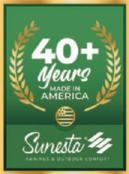





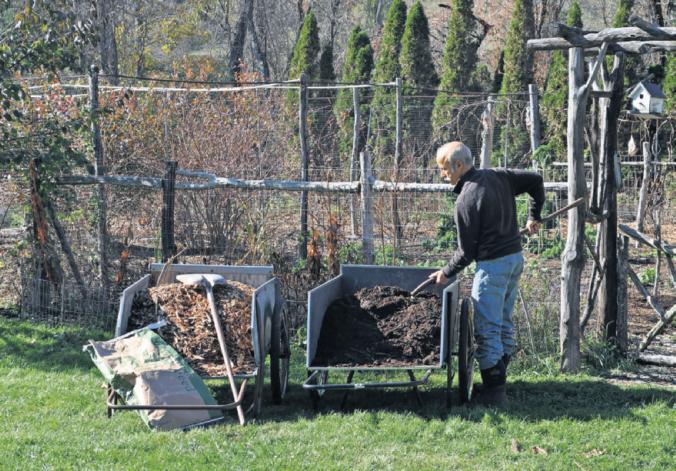
Lee Reich | In the
Plants don’t need haut cuisine
THE OTHER DAY IN THE hardware store I overheard someone ask the clerk for some rose food. My eyebrows went up as I thought to m’self, “Are they kidding, thinking that roses need their own special food? Next, I’ll hear about plants that prefer vegetarian or kosher food, perhaps fish emulsion on Fridays?”
All this food science when it comes to plants may boost fertilizer sales, but it hardly bothers plants either way. Plants take up the bulk of their nutrients as ions (charged atoms or groups of atoms) that are dissolved in water in the soil. Rock particles, as well as humus and organic fertilizers, decompose to release nutrient ions slowly into the soil solution. Chemical fertilizers are already in ionic form, so when you sprinkle a handful on the soil, they dissolve as soon as they contact water.
What’s so special about rose food for roses? Nothing. All plants need healthy doses of nitrogen, phosphorus, and potassium, and lesser amounts of other nutrient elements. But unless a soil is an infertile sand where neither crop rotation nor some weed growth is allowed to balance soil nutrients, specific foods don’t usually have to be tailored for specific plants.
My garden grows pretty well, and I feed all my plants the same diet: An annually replenished mulch of wood chips, leaves, or compost, and, if extra nitrogen is needed, an annual sprinkling of soybean meal. Theoretically and in practice, an inch depth of com-
By Jeanne Huber The Washington Post
Q.post alone provides sufficient nourishment for the plants. That inch depth of compost is the only thing my vegetable beds get each year, and it nourishes closely planted cabbages, tomatoes, lettuces, and other plants from the first breath of spring until cold weather barrels in to shut down production.
Garden plants that are pressed into sustained production (nonstop flowering of those rose bushes, for example) or vegetables best plumped up with extra-succulence, like some leafy vegetables, might need an extra push with additional nitrogen. Or not.
Soybean meal, available in garden centers as well as anywhere selling animal feeds, is insurance in the form of a high nitrogen, organic fertilizer.
Cottonseed meal, hoof and horn meal, alfalfa meal, or blood meal would serve as well. Soil microorganisms decompose the proteins in any of these fertilizers in a series of steps to produce amino acids, then ammonium ions, then nitrate ions. The latter two ions are the forms of nitrogen most utilized by plants.
I grew Brussels sprouts unsuccessfully for many years, with sprouts hardly bigger than marbles lining up along the spindly stalks.
So last year, I sprinkled some soybean meal (2 pounds per hundred square feet) on the ground before laying down the compost. Success! The plants grew into sturdy, five-foot-high stalks along which were lined up almost golfball-sized sprouts.
My daughter used a blue ballpoint pen to put her hair up in a bun and unknowingly wrote on our camel-colored leather chair. We looked online for advice, then tried rubbing alcohol on a spot on the back of the chair, which is never exposed to sun. It looked pretty good, with no change to the color of the leather. We then tried rubbing alcohol on the front and blotted with a Q-tip. That removed the ink but also left a light spot. On a leftover piece of the leather, we tried two types of leather cleaner, which did nothing. Magic Eraser removed some ink but not before creating a light spot. White vinegar also left a white spot but didn’t remove ink. Is there a solution?
A. Stained leather upholstery can be relatively easy to clean — or maddeningly difficult. The kind of stain matters, of course, and so does how long it’s been in place. But the type of leather is what matters most.
Some leather upholstery is bare, with no surface coating. Other leather has a surface finish. And there is in-between leather, with a thin surface coating. Bare leathers, known as aniline leathers because they are colored by being soaked in aniline dye, include pull-up, waxed, oil-tanned, suede and nubuck leathers. They are especially supple and luxurious, but the lack of finish makes them especially vulnerable to stains, scratches and fading. Fully finished leather resists damage much better, but it’s stiff.
The in-between leathers, which are most popular for upholstery, are called semi-aniline. These are colored by soaking in aniline dye, but then they are treated with a finish that has a small amount of color. That evens out the variations left from vat-dying because some parts of a hide are more porous than others. Over the colored finish, semi-aniline leathers get a clear topcoat — not as thick as in fully finished leather, but still enough to block many stains, especially if spills or smears are wiped up quickly. When attempts to remove a stain wind up leaving lighter spots on
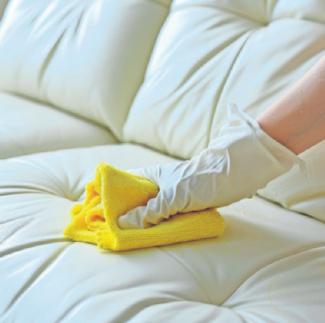
Stained leather upholstery can be relatively easy to clean — or maddeningly difficult. (ADOBE STOCK IMAGE)
leather, that’s a sign that the leather is semi-aniline, said Jason Murray, senior technician for ADV Leather, which sells leather-care products to consumers and professionals and manufactures products sold by other companies under their own labels. If something spills or smears across semi-aniline leather, it’s important to clean it as soon as possible, ideally before the stain works through the coating.
Some companies recommend having leather cleaner on hand so you’re ready to respond to accidents. But things you probably already have in your home may also work, as your test showed. For sticky spills, start by wiping off the material with a damp cloth.
In an emergency, you can also use a few drops of hand dishwashing soap in warm water, although for routine care, it’s safer to use a product labeled for leather care. Leather is acidic and fares better when cleaners are, too, but most household detergents are alkaline. “One incidence of using an alkaline cleaner won’t affect leather much, but continuous use will,” Murray said.
Apply the cleaner to a soft, clean cloth, not directly to the leather, and rub it evenly across the entire surface. Turn the cloth frequently and apply a little more cleaner each time so you don’t wipe the grime you remove back into the leather. (A 16-ounce bottle of ADV Leather Cleaner is $29.90 on the company’s website.)






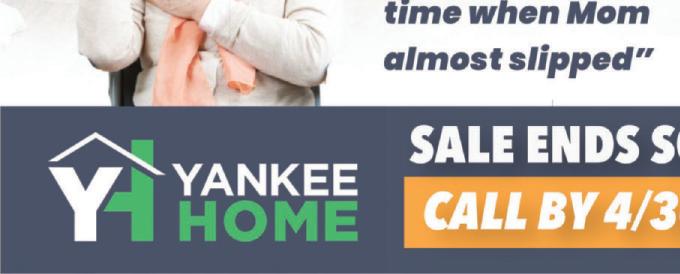




By Jeanne Huber
The Washington Post
Q.About 10 years ago, I replaced the original wired smoke alarms in my home with wired dual sensors that use both photoelectric and ionization technology. Because I’ve read that in-home smoke detectors should be replaced every 10 years, I have looked for replacements. But I’ve found just photoelectric detectors and photoelectric plus carbon monoxide detectors, which I don’t need because we have stand-alone CO alarms. What is the best type of replacement smoke alarm to buy? I would like to add a battery-operated smoke detector in the garage. Can it be connected with the ones in the house? Also, I am considering internet connectivity for the alarm system. In a wired system, should each alarm be connected to the internet? Or do we need only one alarm to be connected to get alerts on our mobiles?
A.Your question about whether to get photoelectric or ionization detectors is easiest to answer. A new testing standard for smoke alarms went into effect in June that requires all new models to be good at sensing both smoldering fires and open flames. Before that, photoelectric detectors were better at sensing smoldering fires and ionization detectors were better at sensing flames. The difference was significant enough that the National Fire Protection Association recommended installing both types, leading manufacturers to make dual-sensing units.
The distinction is no longer relevant as long as you buy sensors that are labeled as meeting the new requirements. The new rules also include a test designed to reduce false alarms: An alarm must stay silent when two

First Alert and Kidde both make bridge units that allow a battery-only detector to communicate with wired-in detectors, creating the interconnected system you want. (ADOBE
hamburger patties are grilled 10 feet away.
Because finding dual-mode sensors isn’t really an issue anymore, figuring out how to link a battery unit with wired-in alarms might seem like your biggest challenge.
Numerous websites say flat-out that it’s not possible and that only wired alarms can interconnect. That’s outdated advice, too. First Alert and Kidde both make bridge units that allow a battery-only detector to communicate with wired-in detectors, creating the interconnected system you want.
The picture you sent shows that your current detectors are made by Kidde. Its bridge unit, P4010ACSCO-W, has only 1.2 out of 5 stars from customer ratings reported on its own website. The company is no longer making it, although some retailers may still have some in stock.
First Alert’s bridge unit, the SA520B, has good reviews but is being replaced by the SM500-AC to comply with new electrical standards; these models are also listed with the same codes as products from BRK, a
sister company. The NFPA warns not to mix detectors from different manufacturers in an interconnected system because the way they communicate might be incompatible. Because you are planning to install new detectors throughout, switching to a different manufacturer is no issue, but if you were just trying to add a battery unit, you’d be wise to stick to one manufacturer or call your current company to ask about compatibility of a bridge unit from a different company.
If you go for First Alert’s products, you could get the SM500V ($59.95 on the First Alert website) for the garage. This alarm runs on batteries and delivers warnings by voice. Note, though, that First Alert does not recommend installing a smoke alarm in a garage because of the risk of false alarms.
But if you aren’t starting a car or running equipment that generates smoke there, the warning probably wouldn’t apply. The new battery-only detector should include “wireless interconnect” as a feature, but that means it can connect wirelessly to a bridge unit
voice commands ($59.95), or the SMI100-AC, an ionization detector that also has voice commands ($34.95 on Amazon).
inside your house, not to your phone.
For the bridge unit, which would link the battery unit in the garage to the other detectors in your house, you could replace one of the wired-in units with the SA520B or, when it is available, the SM500-AC. Finding these could be a challenge if you want to update your alarms soon. A First Alert customer-service representative said there is no estimate of when the new units will be available. The older model, SA520B, is sold out at many companies, although some online retailers still have it in stock.
Elliott Electric Supply, which has dozens of stores in many states, had 256 units in stock earlier this week, although some stores had none. Call before you place an order.
(The SA520B is described on some websites as a battery unit, but it has a way on the back to wire it in, which is what you’d need to do, after you turn off power at the circuit-breaker panel.)
For the other wired-in detectors in your house, you have numerous options, including the SM100V-AC, a photoelectric sensor with
Could the combination of a battery unit in the garage and a bridge unit and wiredin detectors in the house also allow you to monitor the system from afar via cellphone? Not currently with First Alert products, said a customer-service representative who specializes in interconnectivity at First Alert. First Alert did make them, including a model designed to work with Ring, but no new ones are being made while the product is being redesigned. Kidde’s Smoke Alarm with Smart Features also seems to have problems: On the company’s website, more customers gave it one-star reviews (the lowest option) than gave it five stars. Kidde smart alarms that include air-quality monitoring have better reviews.
There are companies that make devices for linking alarms to home-monitoring systems accessible via phone using Z-Wave, a technology protocol that uses a different wavelength than WiFi, thus avoiding interference. The Zooz Z-Wave Plus Smoke and CO Detector Bridge, which lists for $34.95 at TheSmartestHouse. com, is one example. But study the technical details or contact that manufacturer to make sure it would work with whatever smoke alarms you buy. Installation instructions for the Zooz device suggest installing it at the last smoke detector in a wired system because that electrical box doesn’t have as many wired connections. You would need only one bridge for the system.
You’d also need a compatible hub to receive the message. Zooz has tested Ring and ADT systems and verified they work. If you have a different home-security system, you’d need to call the company to make sure.
Terry & Kim Kovel | Antiques & Collecting
WITH APRIL SHOWERS COMES THE question: What do you do with your dripping raincoats and umbrellas? By the Victorian age, wealthy households had hall trees or hall stands in the entryway. They were functional pieces, kept against a wall to save space and featuring a place for everything: coat hooks, an umbrella stand, a bench with storage and often a shelf for small items. They usually have a mirror, too; after all, you want to look your best when you’re leaving the house or visiting someone else’s.
And speaking of looks, hall trees were rarely just functional; they were often highly decorative. This one, which sold at Fontaine’s Auction Gallery for $1,875, was made about 1900, placing it at the end of the Victorian era. In addition to carvings (a closer look under the mirror shows a North Wind face among leaves, perhaps a nod to the weather that makes a hall stand so important) and stick-and-ball decoration, it has a few unusual details. Instead of a storage bench, there is a drawer under the upholstered seat. A colorful leaded glass panel graces the top, and an inset clock adds yet another functional feature.
Q.Could you provide some information about an antique wagon? The “box” part measures 35 inches long by 17 inches wide with a height of 27 inches tall. The mark indicates it is made by the Paris Manufacturing Company of South Paris, Maine. The marking of the underside of the wagon includes “Number 54.” The marking on the underside of the set includes “Number 44” with “54” on top of the “44.”
A. Henry Morton and his wife, Lucilla Forbes started making and hand-painting children’s sleds out of their home in Maine in 1861. The business soon became the Paris Manufacturing Company, with a factory in South Paris by 1884. By the early 1900s, the company employed about 300 people and had become one of the leading producers of sleds and skis in the United States. They even supplied sledges for polar expeditions. By that time, they were also making other wooden products like wagons and children’s furniture. The company was sold to Gladding Corporation in the 1970s, but a group of investors led by Hank Morton, a descendant of Henry, bought it back.
Today, the company operates as Paricon and is still run by the Morton family in South Paris. Antique and vintage wagons by Paris Manufacturing are worth about $200 to $300. The numbers on yours may be model or production numbers.
Q. I have some antique books I would like prices on. There are about 24 little books with green leather covers and some Big Little Books. How can I find someone who wants to buy them?
A. Your green leather books sound like they are from the Little Leather Library, a publishing company founded in New York in 1915. They published classic

Disney characters. In 1938, Whitman changed their name to Better Little Books.
The prices of your books depend on the rarity of the titles. Today, individual Little Leather Library books can sell for about $5 to $30 each. If you want to sell your entire collection at once, it may be worth about $100 to $150. Big Little Books are usually under $20 each. The easiest way to sell books like these is through a local used bookstore.
TIP: Early mirrors, those made before 1850, had thin glass. To judge the thickness of a mirror, hold a pencil point against the glass. The difference between the point and the reflection is the thickness.
Current prices are recorded from antiques shows, flea markets, sales and auctions throughout the United States. Prices vary in different locations because of local economic conditions.
Bow, Limoges, footed, purple flowers on branches, gilt trim, green mark, 15 inches, $50.
Clock, Coca-Cola, round, red center, Drink Coca-Cola, metal, Telechron, 1951, 18 inches, $60.
Purse, mesh, art deco style, black and white chevrons, fringe, metal and enamel frame and chain, black and white, satin lining, interior pocket, 6 x 5 inches, $70.
Silver plate, coffee urn, neoclassical, urn shape, dome lid, ball finial, tall handles, faceted body, swags, spigot, square base, scalloped, four ball feet, 24 inches, $75.
Lamp, Bradley & Hubbard, paneled shade, pierced stylized flowers, caramel slag glass, marked, 25 x 20 1/2 inches, $200.
Textile, wall hanging, embroidered, pictorial, two cranes, marsh landscape, trees, bamboo, flowers, silk, Japan, late 1800s, 83 x 63 inches, $350.
Toy, wagon, milk, red paint, yellow trim, black stencil, six tin cans, spoked wheels, mohair horse, brown, leather harness, wheeled platform, marked, S. Kann Sons Co., 9 1/2 x 27 inches, $440.
Majolica, umbrella stand, turquoise blue ground, two birds, storks, raised leg, fish in beak, cattails, brown trim, 1880s, 21 inches, $750.
literature titles in miniature format for affordable prices. They were first made as advertising premiums for the Whitman’s Candy Company of Philadelphia. Then they were sold at retailers like Woolworth’s, where they cost 10 cents each. The green covers are synthetic leather, which the company started using during World War I. By 1922, they changed the books’ binding to a shiny red leatherette and operated as the Little Luxart Company.
The company stopped publishing books in 1925. By then, they had published 101 public-domain titles and sold more than 25 million books. Big Little Books were published by the Whitman Publishing Company in Racine, Wisconsin, (not to be confused with the candy company) starting in 1932. They were about 3 1/2 by 4 inches, had full-page illustrations and originally cost 10 cents each. The first title was “The Adventures of Dick Tracy.” Other Big Little Books also featured popular radio, comic strip and film characters, including
Furniture, linen press, mahogany, split scrolled crest, scallop finial, twist pilasters, two doors over two short over two long drawers, England, 1800s 85 1/2 inches, $900.
Vase, Baccarat, Eurydice, oval, lobed, flared neck, collar, diamond band around shoulders, pedestal base, round foot, marked, Musee des Cristalleries de Baccarat, late 20th century, 19 inches, $1,200.
Terry Kovel and Kim Kovel answer readers’ questions sent to the column. Send a letter with one question describing the size, material (glass, pottery) and what you know about the item. Include only two pictures, the object and a closeup of any marks or damage. Be sure your name and return address are included. By sending a question, you give full permission for use in any Kovel product. Names, addresses or email addresses will not be published. We do not guarantee the return of photographs, but if a stamped envelope is included, we will try. Questions that are answered will appear in Kovels Publications. Write to Kovels, The Republican, King Features Syndicate, 628 Virginia Dr., Orlando, FL 32803 or email us at collectorsgallery@kovels.com.
By A lex Veiga Associated Press
The average rate on a 30-year mortgage in the U.S. edged lower for the second week in a row, a modest but welcome boost for prospective home shoppers in the midst of the spring homebuying season. The rate fell to 6.64% from 6.65% last week, mortgage buyer Freddie Mac said Thursday. A year ago, the rate averaged 6.82%.
The average rate has mostly trended lower since reaching just over 7% in mid-January. When mortgage rates decline, they boost homebuyers’ purchasing power. Borrowing costs on 15-year fixed-rate mortgages, popular with homeowners refinancing their home loans, also fell this week, pulling the average rate down to 5.82% from 5.89% last week.
A year ago, it averaged 6.06%, Freddie Mac said. Mortgage rates are influenced by factors including bond market investors’ expectations for future inflation, global demand for U.S. Treasury’s and the Federal Reserve’s interest rate policy decisions.
The overall decline this year in the average rate on a 30-year mortgage loosely follows moves in the 10-year Treasury yield, which lenders use as a guide to pricing home loans. The yield, which was nearing 4.8% in mid-January, has mostly fallen since then, amid signs that the economy is slowing and worries that tariffs imposed by the Trump administration on goods imported from around the globe could hurt economic growth and fuel inflation.
The yield slid to 4.06% Thursday as a sharp sell-off on Wall Street following the White House’s latest and most severe volley of tariffs fueled expectations among bond investors that the Fed may have to cut its main interest rate if the economy sours.
Thomas Russo Jr., to Megafino LLC and Thomas Russo Jr., life estate, 204 Suffield St., $425,000.
Shelly A. Perdomo-Ahmed and Amer Ahmed to Vincent Charles Gaffney and Micah Ariel James, 5 Stony Hill Road, $760,000.
Cynthia Durkee, personal representative, Margaret Webster Lyman, estate, and Margaret W. Lyman, estate, to YOLI LLC, 75 Mechanic St., $345,000.
William B. Appleton, trustee, Sheryl J. Appleton, trustee, and Sheryl J. Appleton Living Trust to Brad Spry, 23 Greenleaves Drive, $246, 000.
Laura Lee Finck to Maxwell Finck and Nicholas Finck, 294 Buckland Road, $225,000.
Lisa Cousin to Song Liang, trustee, Jin Chen, trustee, and Southwest SY J Family Revocable Trust,68 Jackson St., $586,000.
Eric D. LeBeau and Ashley L. LeBeau to Eric LeBeau, trustee, Ashley L. LeBeau, trustee, Eric & Ashley LeBeau Revocable Trust, 20 Mountain View Drive and 225 State St., $100.
Donna DiGeorge, Jordan DiGeorge and Scott DiGeorge to Tyler A. Nolan, 102 Bald Mountain Road, $580,000.
Mohammad E. Taslim, trustee, and Brimfield Realty Trust, trustee of, to Ralph W. Nichols, Bonnie Nichols, Sarah J. Nichols and Michael D. Nichols, Route 20, $630,000.
Paula Moltzan and Ryan Mooney to Jenna M. St. Pierre and Geeg Wiles, 31 Mountain View Drive, $93,000.
Steven Amter and Elizabeth Behl, trustees of the Elizabeth Behl Revocable Trust, to Christopher Seaver and Julie Seaver, South Heath Road, “aka” Harris Road, $20,000.
Francis Gagnon and Donna Britton to Jacob Beaudette and Dakota Beaudette, 54 Route 20, $242,000.
Antoinette Wegrzyn to Jonathan G. Barroso, 60 Stewart St., $295,000.
Veterans Action Association Inc., to Locke Properties LLC, 175 Pendexter Ave., $170,000.
Edythe M. Ambroz and Barbara W. Graves to Wei Yan and Rong Shao, 31-33 Alvord Ave.,
$370,000.
Jarrid Kendall to Ashley N. Feliciano, 69 Rochester St., $340,000.
Jennifer A. Corridan, representative, Gary A. Godin, estate, and Gary Godin, estate, to Taylor Yim, 61 Abbey Memorial Drive, Apt 156, $224,000.
Linda E. Papuga, Richard F. Hayden Jr., and Scott T. Hayden to Veteran Stan LLC, 3 Graham Drive, $166,000.
Manchester Enterprise LLC, to Joseph A. Moreau, 18 Villa Lane, $350,000.
Richard A. Valcourt to Theresa L. Clancey, 104 Waite Ave., $50,200.
Robert A. Peloquin and Annette L. Peloquin to Katie Boucher, 1766 Memorial Drive, $100,000.
Robert Jacques to KMAK LLC, 19 Montello Road, $212,000.
Janet B. Ryan to Barry David Elson and Heidi Lynn Hobby, Roaring Brook Road, $35,000.
Leodore Champigny and Leanne Champigny to David Viner, 151 Bryant Road, $249,000.
Carol A. Ray to Geovanni Montesino, trustee, Madelaine Saborit, trustee, and Montesino Property Management Realty Trust , trustee of, 40 Benjamin St., $380,000.
Frank D. Pennell and Helen M. Pennell to Nabeel R. Ahmed and Ramisa Rahman, 134 Pinehurst Drive, $399,900.
Jonathan A. Miorandi and Jonathan Miorandi to Ebak Projects LLC, 62 Baymor Drive, $291,000.
Tanya L. Minassian and Nicole S. Meregian to DL Stephenson, 217 Pinehurst Drive, #217, $455,000.
Patricia A. Dubiel and Patricia A. Venne to Jonathan R. Venne, trustee, Lindsey E. McGrath, trustee, and Paricia A. Dubiel Irrevocable Trust, 8 Concord Drive, $100.
David Chu and Lonnie Chu to Phoebe A. Lamont, 25 Lyman Ave., $280,000.
Harley Colgan Properties LLC, to James Robert Donais, 131 West St., $549,900.
Parsons Ferry Street LLC, to Bryan Emond, 70-72 Ferry St., $425,000.
Edythe M. Ambroz to and Barbara M. Graves to Amy L. Saletnik, 10-12 Berkeley St., $320,000.
Marc Lariviere and Susan Lariviere to Kate Laverdiere and Emily McLaughlin, 114 New Ludlow Road, $100.
Carolyn Roberts and Kenneth J. Roberts Jr., to Chocorua Construction LLC, 2 Circle Drive, $220,000.
DGL Properties LLC, to Jarrid Kendall and Allison Boyden, 36 East St., $600,000.
Milton H. Stauffer to Jenna L. Nicol, 1665 Main
Road, $335,000.
David R. Staelens and Samantha M. Staelens, “fka” Samantha M. Staelens Daley, to Bryna Ziobro, 44 Spring Terrace, $265,000.
Justin Allenby and Michelle Allenby to Charles E. Jacques and Karen J. Jacques, 2A “aka” 25 Keegan Lane, Unit 2A College Park Condominium, $115,000.
Melissa C. Bliven, “aka” Melissa C. Noyes-Bliven, “aka” Melissa C. Noyes, and William B. Bliven Jr., “aka” William B. Bliven II, to Katherine Bryce Bargar and Emma Yaffe, 51 Beech St., $225,000.
Quality Realty Partners II, LLP, to Servicenet Inc., 55 Federal St., Units 105 and 110, 55 Federal Street Condominium, $168,414.
John Campbell and Susan Herbst to Jason Kotoch and Emily Norton, 63 Pierce St., $409,000. Quality Realty Partners II, LLP, to Zervas Dentistry PLLC, 55 Federal St., Units 210, 230 and 310, 55 Federal Street Condominium, $116,490.
Joanne M. Despres to Thomas Despres, Susan M. Despres and Amelia C. Prior, 12 Farm Lane, $100.
James C. Fass and Mary H. Fass to Carol Hunt and Paul Hunt, 221 Bennett Road, $495,000.
Fannie Mae, Federal National Mortgage Association and Albertelli Law, attorney-in-fact, to Gregory Thomas Ludwiczak, 44 North St., $431,000.
Melissa Clark and Melissa Caragulian to Barry J. Picard, Linseed Road, $15,000.
Gary L. Bridgman and Marta D. Pajak-Bridgman to Sean S. Yarrows and Makayla Caliri, 533 Old County Road, $62,500.
David Hart, representative, Robert K. Goss, estate, Meghan Harrison, representative, Norberta G. Hart, estate, and Norberta E. Hart, estate, to Dale Deslippe, 38 Upland Road, $260,000.
Edith Salgado and Ruth Salgado to Christine H. Dibella, trustee, and Christine H. Dibella Trust Agreement, trustee of, 413-415 Hillside Ave., $455,000.
Francis M. Croke and Louise M. Croke to Holyoke Medical Center Inc., 10 Hospital Drive, Unit 14, Ste. 303, $130,000.
Ivis N. Ayala and Saturnino Maldonado to Sharlyn Rivera, 334 Maple St., $170,000.
Rehab Home Buyers LLC, to Reinaldo Ruiz Torres, 238 Lyman St., $320,000.
Ronald LaMagdeleine, Cynthia R. Wagner and Cynthia R. Weltlich to Kaleb Trombley, 8 Rugby St., $235,000.
Wells Fargo Bank, trustee, and Option One Mortgage Loan Trust 2005-4 Series 2005-4, trustee of, to Fitzgerald Home Solutions LLC, 44 Washington Ave., $136,500.
Mechanic Man LLC, to John Glynn and Noah Goldstein, 16 Knightsville Dam Road, $100.
Michael P. Bombich and Sarah A. Bombich to Rebecca E. Lindsay, 121 Wilkin Drive, $300,000.
Susan Choquette, Susan R. Choquette and Gene A. Choquette to Gene Alan Choquette, 184 Edgewood Ave., $100.
Elizabeth F. Crinella to Lisa Cousin, trustee, and L. Cousin Trust, trustee of, 308 Miller St., Unit 17, $400,000.
Lillian F. Baginski, trustee, LFB Nominee Trust, trustee of, and LFB Revocable Trust, trustee of, to Mariana Goncalves, 9 Waters Edge, $230,000.
Randy P. Pascale and Kim K. Pascale to VDS Properties LLC, Prospect Gardens Par B, $125,000.
Steven J. Mastalerz to Mary P. Mazza, 517 Ideal Lane, Unit 203, $379,000.
William Raleigh and David Kachinski to Ludlow Housing Authority, 54 Cady St., $345,000.
Anthony Poehler, Samantha Poehler and Samantha Shea to Nathan Murch, 51 Stafford Road, $392,500.
Nichole M. Malone to Anthony Plescia Jr., and Jessica Plescia, 210 Moulton Hill Road, $435,000.
Jessica K. Adamites and Neil A. Young to David William Galvin III, and Matthew Benjamin Lee, 61 Central St., $240,000.
Philip J. Villeneuve to Kathryn A. Sisson and Marshall W. Sisson, 45 Millers Falls Road, $175,000.
William S. Andrews to Emily Hughes and Liam H. O’Brien, 17 Old Sunderland Road, $585,000.
Eric C. Clukey and Sunny R. Clukey to Jeffrey M. Cringan and Kimberly A. Cringan, 168 Blackinton Road, $425,000.
Ariella Yosefa Rosen and Rebecca
Lillian Walker to Kimberly M. Malcolm, 70 Hatfield St., $449,900.
Owen G. Mohan, Lisa A. Snook-Mohan and Lisa A. Snook to Owen G. Mohan, 149 Jackson St., $100.
Owen G. Mohan to Owen G. Mohan, Lisa A. Snook-Mohan and Lisa A. Snook, 149 Jackson St., $100.
James J. Flannery Jr., to Katherine Chung and James Hallisey, 16 Glendale Road, $320,000.
Lauren Katz to Eleanor W. Lin, 214 Fairway Village, $405,000.
The Moody Center Inc., to Thomas Aquinas College, 61 Winchester Road, $100,000.
David C. Brooks, trustee of the Western New England Trust VIII, to Maryjane Dwyer, 258 Old Wendell Road, $289,900.
Dream Home Investments LLC, to Clelviano Martins Leao and Tatiane Vila Nova Martins, 507 East Main St., $350,000.
Albert M. Rousseau and Shala M. Rousseau to Kevin Joseph Wisniewski and Lori Lynn Wisniewski, 61 Shadow Lane, $570,000.
Adrienne L. Mercier and Jeffrey M. Ashline to Lykabiko LLC, 6 Brown St., $206,000.
Dominic Kirchner II, trustee, and A-O-K Realty Trust, trustee of, to Derek Beaulieu and Laurie Palatino, 23 Burlingame Road, $340,000.
Fannie Mae and Federal National Mortgage Association to Christopher Konstantin, 46 Meadowbrook Lane, Unit 46, $188,150.
Gerald E. Mega to Dominic Kirchner II, trustee, and Jehoram Realty Trust, trustee of, 29 Griffin St., $60,000.
Vernon Olson Jr., and Sherri A Olson to ARPC LLC, 26 Fox St., $102,500.
James E. Tierney Jr., and Patricia M. Tierney, to James E. Tierney Jr., trustee, Patricia M. Tierney, trustee, James E. Tierney Jr. Living Trust and Patricia M. Tierney Living Trust, 13 Spring Meadows, $100.00.
Kye E. Poronsky to Ryan L. Kile, 23 Columbia St., $322,000.
Brett Remillard to Alan Keeley and Katherine McAuliffe, 1 McDowell Drive, $435,000.
James T. Tomaszewski and Connie L. Tomaszewski to Benjamin P.
Tomaszewski, Pamela Tomaszewski McLean and Lisa Tomaszewski Askew, 37 Noel St., $100.
Debra Brunelle-Hay, Debra Ann Saccoccio and John Hay to Holly A. Martineau and Steven G. Martineau, 205 Alvord Place, $386,000.
Dianne E. Walsh to 2 Black Cats LLC, 7 Hunter Terrace, $300,000.
Patricia Mae Matty, trustee, Patricia M. Matty, trustee, Michael R. Matty, trustee, and Patricia Mae Matty Revocable Trust to Patricia Mae Matty, 22 Spring Meadows, $100.
Vyacheslav Katko, trustee, and County Road Revocable Trust to Dmitriy V. Mikhaylichenko, 0 County Road, $130,000.
Renee J. White to Julie Jernstrom, 111 Pomeroy Meadow Road, $310,000.
Charles D. Spurlock and Charles Spurlock to Thomas R. Maynard and Donna L. Maynard, 48 Pineywood Road, $300,000.
Jeremy Lafleche to Julia P. Hall and Brandon Gallacher, 91 Powder Mill Road, $241,000.
Susan J. Beekmann, Susan J. Turrini, Loriann L. McKain and William A. Lindsay to Suzanne Carmel, 6 Iron Horse Hill, Unit 23B, $500,000.
1131 Boston Road LLC, to R&R Home Improvement & Remodeling LLC, 1131 Boston Road, $510,000.
Alex Reyes and Alexander Reyes to Diana Pena Peralta, 36-38 Santa Barbara St., $360,000.
Alphonso T. Can and Mimi Phan to Jose Armando Irizarry Feliciano, 28 Pemaquid St., $273,000.
Brandee Lynn Baker to Robert L. Hernandez, 45 Georgetown St., $262,600.
Bretta Construction LLC, to Jessica Villafane and Roberto Villafane, 131 Samuel St., $500,000.
Brian S. Dixon, trustee, and BJB Revocable Trust, trustee of, to KHL Group LLC, 90 Berkshire Ave., $440,000.
Catic Acquired Properties LLC, to Post Investment LLC, 134-136 Bay St., $45,000.
Damon A. Bermudez, Damon Bermudez and Paola Marie Hernandez to Wendy Sulewski and Isaiah L. Harris Sr., 71 Westford Circle, $220,000.
Daniel Bedore, representative, and John Peter Bedore, estate, to Shigen Zhu, 15 Alice St., $155,000. David G. Manferdini, representa-
tive, and Shirley M. Manferdini, estate, to Maria A. Cotto, 130-132 Mooreland St., $395,000.
Delores I. Weir to Mohamed Mohamud Arbow and Yasin Bakar Arbow, 18-20 Middlesex St., $348,000.
Dnepro Properties LLC, Bluprint Spaces LLC and Blueprint Spaces LLC, to Enrique Soto, 15-17 Bloomfield St., $450,000.
Emtay Inc., to Luis Veras, 74 Cherry St., $300,000.
U S A Housing & Urban Development to Tok Chang, 27-29 Rapalus Ave., $220,000.
Eric D. Alves to Ondina A. Flores Hilario, 189 Essex St., Unit S, $200,000.
Jennifer Cruz to Dnepro Properties LLC, 60 Superior Ave., $222,500.
Jeremy D. Scott and Alyssa Scott to Lisette Torres, 41 Briggs St., $225,000.
John J. Ferriter, administrator, and Bernard E. Best, estate, to Lotcus LLC, 89 Grand St., $136,500.
John L. Wajdula to Plus Realty LLC, 381 Main St., $470,000.
Kathleen M. Pollard-Haskell to Sareen Holdings LLC, 65 Edgemont St., $176,000.
Lloyd Cameron and Joel Lugo to Melissa Camille and Cyndy Camille, 125 Yale St., $397,000.
Louis F. Dirienzo Jr., and Allison Dirienzo to Molli Mowry and Ian Leonard, 105 Oregon St., $370,000.
Maria F. Alban and Angel O. Alban to Marina Martinez Lopez, 75 Shamrock St., $280,000.
Martha E. DiMauro to Virginia Omega Pearson, 132 Birchland Ave., $315,000.
Muhammad Akbar to Ivelisse
Ramos Aponte and Luis Alexis Moran Lozada, 827 Berkshire Ave., $294,000.
Neha Chavan and Pratik Mandavgade to Nishant Mathur, 72 Waverly St., $385,000.
NZ Property LLC, to R&R Home Improvement & Remodeling LLC, 211 Glenoak Drive, $245,000.
Oakwood Asset Management LLC, to Islande Zetrenne, 491-493 Wilbraham Road, $370,000.
P&R Investments LLC, to Fumi Realty Inc., 62-64 Bristol St., $225,000.
Patricia A. Tucker and Christopher Larrivee to Kimone Wedderburn, 83 Gilbert Ave., $279,000.
Roberto Villafane and Jessica Villafane to Jonathan Luis Romero, 328 Newhouse St., $323,000.
Sareen Properties LLC, to Imam Sadeq Islamic Foundation Inc., 1786 Wilbraham Road, $200,000.
Stacey L. Canady and Thomas F. Canady Jr., to Jose Angel Ortiz, 44
Wilson St., $200,000.
West Jam Man LLC, to Nelson Zayas Hernandez, 141 Parkerview St., $325,000.
Wicked Deals LLC, to Unlimited Construction Services Inc., 208 Osborne Terr, $195,000.
Yevgeny Shrago, representative, and Victoria Talyansky, estate, to NRES LLC, 25 West Crystal Brook Drive, $170,000.
Suzanne B. Wells and William W. Wells to Jay Russell Johnson Sr., 4C Pomeroy Lane, Unit 4C Buttonball Meadow Condominium, $450,000.
Armand Thibert to Christopher Figueroa, 5 Church St., $11,000.
Gary S. Pfisterer to Deirdre E. Cullen and John J. McCarthy II, 15 Shaw Road, $92,500.
Clifford G. Harris and Susan J. Harris to Clifford G. Harris, trustee, Susan J. Harris, trustee, 0 Upper Church St. and 193 Upper Church St., $100.
Adonis P. Edwards to Jessica Edwards, 15 Gould Road, $100.
Adonis P. Edwards to Adonis P. Edwards and Jessica Edwards, 18 Fourth Ave., $100.
Darrin R. Brown to Reliance Holdings Corp., 13 Richfield Ave., $195,000.
Frederick H. Abbott III, and Kathryn E. Abbott to Jedathan Richardson, 188 Old Winchester Road, $355,000.
Christopher N. Williamson to David Dearden and Michelle Dearden, 318 Lancaster Ave., $321,000.
Jay W. Berger, Kelly A. Berger and Kelly A. Curry to Elizabeth Ann Curry, 64 Worthy Ave., $290,000.
Kiran Gotamay and Partiman Gautam to Durga Dahal, 40 Moseley Ave., $308,000.
Patrick J. Powers, trustee, Cynthia F. Powers, trustee, and Patfran Trust, trustee of, to Douglas S. Abel and Debra A. Abel, 36 Silver St., $275,000.
Robert Donald Spano and Jessica A. Theulen to Birman Tamang, 45 Oakland St., $327,500.
Roberta A. Martin to Yasir Al Musali and Raghad Al Samraee, 594 Dewey St., $330,000.
Two kinds of stains can be especially difficult to deal with: dye transferred from fabrics and ink from ballpoint pens. Decorative pillows, especially in bright red or pink fabric, sometimes have excess dye that rubs off onto leather. New, unwashed blue jeans can also transfer color.
Rubbing alcohol can sometimes remove transferred dye, and it dissolves fresh ballpoint pen ink, as you found. But in both cases, too much alcohol can also take off some of the color finish on the leather, especially if the clear coat is already damaged. Ink stains cover smaller areas than transferred dye, so you have a better chance of removing those stains without also taking off some of the leather color.
Dab the alcohol onto an ink stain with a cotton swab rather than rubbing it on with a cloth, so you put the alcohol just where it’s needed. If you have a handful of swabs, switch to fresh ones often to avoid smearing the softened ink on nearby leather. If you don’t have rubbing alcohol on hand, use alcohol-based hand sanitizer.
Be aware that you might be more successful on some parts of the upholstery than others. Christopher Repp, a professional leather repairer who offers do-it-yourself advice on his website, LeatherHelp.com, said that the topcoat on the back of your chair was probably as good as new, while the coating on the front had probably worn through from use or been damaged by the sun. There, the rubbing alcohol dissolved the ink, but it also stripped some of the color.
On bare leather, stain removal is even more difficult. Just plain water can make the leather turn darker. Blot up spills as quickly as possible. Then scrape off as much as you can, rather than trying to wash a stain away. But if there is sticky

residue, you probably need to rinse, ideally with distilled water. Use a hair dryer to speed drying.
It’s usually futile to try to remove stubborn stains, Murray said. Instead, try applying colored finish over the area, as if you were painting over graffiti. A similar approach also works to even out color when stain removal has left light patches on semi-aniline leather.
The biggest challenge is to get an exact color match, which is especially important if the marks are in a prominent place, such as the center of a seat cushion. Companies like ADV Leather can custom-match the color if a customer sends in a small sample of the leather. Customers often harvest a swatch from a small piece that manufacturers often attach under a cushion, or they tip over the sofa or chair and clip off a little extra leather underneath the frame.
ADV Leather sells finish in both stock and custom colors — but the custom colors require color-matching, which costs $125. ADV Leather can also match
colors of Benjamin Moore paint swatches, which works great when customers want to refinish a whole chair or sofa. But this is riskier for a spot repair because a color that’s close but not exact can still be quite noticeable, Murray said.
It’s also possible to buy leather dye at a craft store or online and custom-match the color yourself. You’d probably need to get several related colors, such as light, medium and dark brown if the leather is brown. Then mix them to get the precise shade you need. “If you have an eye for color, it is not impossible to get it right,” Repp said. It helps to have leftover pieces of the same leather to test how touch-up dye will look once it dries.
Or, of course, you could hire a professional. It might cost only a little more than getting a custom-match color and doing it yourself, especially if you do it right by starting with primer and winding up with a touch-up to the clear coat. Repp makes house calls in the Baltimore/Washington area and would charge approximately $275.
Abdias Garcia and Amber N. Garcia to Lyubov Korobkova, Vitaliy V. Korobkov and Vitaliy Korobkov, 162 Old Cabot Road, $675,000.
C&M Builders LLC, to Abdol Hossein Sharifi, 532 East Mountain Road, $475,000.
Daniel A. LeClair, representative, and William N. LeClair, estate, to Raymond J. Salois Jr., and Darlene E. Biggs, 77 Roosevelt Ave., $260,000.
Daniel W. Stephenson and Sandra C. Wheeler to Xuelin Jin and Lianyu Yu, 49 Ingersoll Drive, $434,400.
Jack R. Davis to Brandee Lynn Baker and Alfie Jerome Davis, 284 Paper Mill Road, $329,000.
Kara M. Graves to Melissa Radle and John O’Connor, 168 Susan Drive, $435,000.
Talia Phaneuf, Talia M. Phaneuf, Talia Scalise, Talia M. Scalise and Jason Phaneuf to Morgan Priem and Christopher Delostrinos, 57 Crane Ave., $340,000.
Diane Wojcik and Nicholas M. Wojcik to Christina G. Forbush and Augustus Prescott Gaylord, 23 Conway Road, $833,000.
John F. Moynihan, trustee, Joanne Moynihan, trustee, and Moynihan Family Irrevocable Trust, trustee of, to Melonie Jackson, Sandalwood Drive, Unit 20, $649,900.
Julia Anne Eastman to Anne Fairbanks Griswold, 28 Pomeroy St., $361,800.
Pelletiere Family Trust, trustee of, and Cheryl Barker, trustee, to Steven J. Paolucci and Lori A. Paolucci, 41 Cherry Drive, $400,000.
CONTINUES FROM PAGE F4
Flowers and mature trees and bushes get nothing more than arborists’ wood chips, leaves, or wood shavings here. Even these low nitrogen mulches eventually release nitrogen as their lower layers break down in the soil.
You might point out that, still, there are some plants that need a specialty plant food: “acid plant food” for azaleas and rhododendrons, for example. You’ve got a point; these plants do have
special needs. But my universal pabulum of mulch and soybean meal also suffices for them.
The special requirement of these plants is an acid soil. If a soil is not naturally acidic, the soil doesn’t need an “acid plant food,” it needs to be made acidic. The way to make a soil acidic is with sulfur, a naturally mined mineral.
The amount needed depends on the existing soil acidity (determined with a quick soil test), the desired soil acidity (a pH of about 5 for acid-loving plants), and
whether the soil is sandy or clayey. A sandy soil needs about 3/4# per 100 sq. ft. for each pH unit change; clay soils need about two-and-ahalf times that amount. The sulfur to use is “pelletized” because it’s less dusty to work with. And, obviously, any compost for these plants should have had no added limestone. What about the special nitrogen requirement of these plants? Commercial “acid plant food” supplies acid-loving plants with their preferred form of nitrogen, which is ammonium ion.
Let’s see what happens to my soybean meal in an acid soil. A few paragraphs earlier, I wrote that though an orchestrated series of steps, various soil microorganisms gobble up proteins in soybean meal or other organic fertilizers, breaking them down to amino acids, ammonium ions, and then nitrate ions. In acidic soils, microorganisms that do that last job are absent. Breakdown stops at ammonium ion — just what those plants like best. Plants don’t need haute cuisine, just plain, wholesome food.
Gary R. Benoit and Dawn M. Benoit to Cas Ford Rego-Martin and Jesse Taylor Rego-Martin, 8 Grove St., $250,000.






Wednesday, April 9, 2025
11:00 AM - SPRINGFIELD
70 Massasoit Street a/k/a 68-70 Massasoit Street
2 fam, 3,749 sf liv area, 0.1 ac lot, 14 rm, 8 bdrm, 2F/2H bth, Hampden: Bk 16241, Pg 127 12:00 PM - EASTHAMPTON 5 Morin Drive sgl

NORTH CHELMSFORD (978) 251-1150 www.baystateauction.com
1029,

